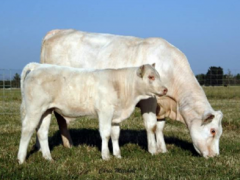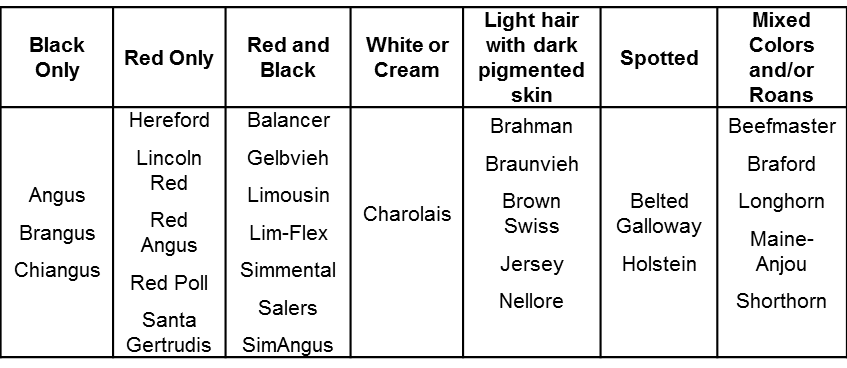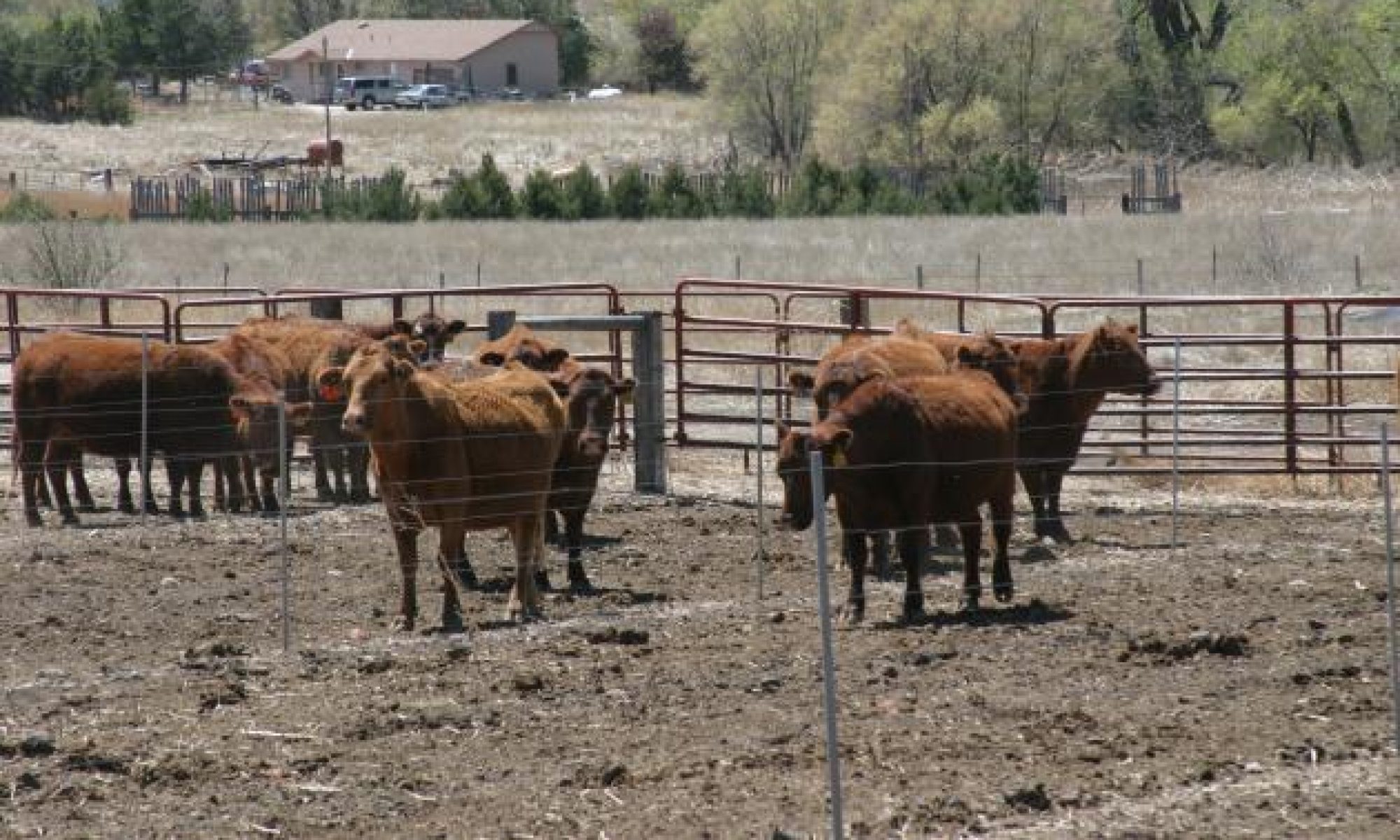
Color Patterns in
Crossbred Beef Cattle
Megan Rolf
Oklahoma State University
mrolf@okstate.edu
*Click here for printable pdf version.
Summary: Understanding the genetic basis of coat color can help create more uniform progeny groups and aid in marketing crossbred calves.
Crossbreeding provides commercial cattlemen the opportunity to combine desirable characteristics of two or more breeds (breed complementarity – see fact sheet 2014-5) and increase performance due to hybrid vigor (heterosis). The single strongest argument for crossbreeding is the advantage in fertility and longevity of crossbred cows. With all of the advantages crossbreeding provides, designing an effective mating system should be a top priority for all commercial cattlemen. To plan an effective crossbreeding system, it is helpful to consider any potential detractors that are easy to address. One such detractor exists due to market discrimination against certain breeds and/or colors and lack of uniformity in color. As we increase the number and diversity of breeds involved in crosses, we decrease our ability to maintain complete control of coat color in the offspring unless it was taken into account during breed selection. With that in mind, knowing the basics of coat color inheritance can help producers know what to expect from various breed/composite pairings relative to color pattern.
The purpose of this fact sheet is to provide guidance on how to maintain a uniform color pattern when formulating crossbreeding systems. In some breeds and breed crosses, the color is highly predictable; however, in some other breeds and breed crosses, color is less predictable. A working knowledge of the inheritance of coat color will aid in planning for the color pattern to expect among calves when crossing breeds. This can be very important for evaluating marketing options either at weaning when forming large group lots or on the rail when targeting specific branded beef programs.
Many breeds of beef cattle have a fixed color pattern for that breed because selection has been placed on the color in order to maintain these characteristics. For example, all Hereford cattle have a red body color with a white face, all Charolais are white, and all Red Poll are red. However, other breeds may have more than one basic body color such as red or black Limousin or Simmental, and white, red, or roan Shorthorn. Still other breeds have multiple colors with more unpredictable inheritance patterns, such as spotting, brindling, or stripes in Longhorn and Beefmasters. Some color modifiers under genetic control have been selected against in many breeds (unless they are a feature of color in the breed, such as in Charolais or Hereford) and these features, such as “diluters” and blaze faces, are much less common than in the past which makes the process of managing color in crossbreeding systems much easier.
Table 1 shows several common breeds of beef cattle and the predominant color pattern that is most commonly associated with each breed. Recently, some breeds with unique color attributes such as spots, blaze faces, and diluter genes have selected against these traits to increase favorable perceptions by terminal buyers. Other breeds that were traditionally red have selected heavily for black coat color and are listed in Table 1 as both black and red. Introgression of other breeds (specifically Angus) into some of the Continental breeds has altered the traditional color pattern of some of these breeds. Color patterns likely to result from specific crosses are detailed in Table 2.
|
Table 1. Basic body colors of common cattle breeds. |
 |
|
Table 2. Color pattern expected in progeny resulting from the matings of bulls and cows of various colors. |
 |
All animals are carriers of mutations somewhere in their DNA for one or many recessive traits. Because an animal must inherit two copies of a given recessive mutation to be affected, and with only a few animals typically sharing the same mutation in the whole population, there is rarely a mating cross that has the potential to create affected offspring under natural selection. It is when relatives are mated that there is the possibility that offspring will inherit the mutant allele on both sides of the family tree.
When you have crossbred cows, predicting color in the offspring can be more difficult, but it helps to understand how color is inherited. All cattle basically possess one of three basic colors: black, red, or white. Black is dominant to red, and both black and red are co-dominant with white. One black or red allele with a white allele would result in either a black or red roan animal. In order for an animal to be red or white, they must have two alleles for either red or white, respectively. There is another set of alleles that controls the dilution, or intensity, of that color. Dilution causes black to be muted to gray and red to be muted to yellow. As an example, Charolais cattle are red, but possess two alleles for dilution, which results in white coat color (Gutiérrez-Gil et al. 2007). This is why Charolais x Angus cattle are gray (diluted black). A very thorough discussion of coat color in cattle, including its many variations (Table 3) can be found at http://simmental.org/site/pdf/other/olsoncolor.pdf.
|
Table 3. Description of known coat color patterns in cattle (adapted from Olson 1999). |
 |
In a typical sale barn market, cattle are sold with little, if any, information made available about breed or performance. Many buyers will estimate performance (growth, carcass characteristics, etc.) in relation to the reputation of the breed; thus, they may look for signs that indicate a certain breed or breeds within crossbred cattle. Other buyers may be looking to source animals that qualify for black- or red-hided branded beef programs and are willing to pay a premium for these types of calves. Some breeds are prone to producing calves that have certain distinguished color markings, such as white-faces, brindling, or white stockings on their legs.
Some general rules can be utilized to give the greatest chance of obtaining uniformly-colored groups of calves. Because red is recessive to black coat color, breeding solid red cows and bulls will produce solid red calves, which makes solid red an easy color to maintain in a crossbreeding system. However, because black is dominant to red, breeding solid black bulls and cows will often produce black calves, but may also yield red calves. To ensure a solid black calf crop, breed solid colored females (without diluter genes) to a homozygous black bull. If black baldy calves are desirable, use of Hereford bulls on black cows (or black bulls on Hereford cows) will yield the desired effect. If color extremes in the cowherd are a major concern, they can be masked by breeding over several generations to Charolais bulls.
In today’s market, where marketing branded beef is advantageous, knowledge of coat color inheritance is essential. Even under traditional marketing systems, uniformity in coat color can often provide premiums/discounts in the market place. Therefore, knowing the basics of color inheritance will help in planning crossbreeding systems that create animals that are suitable for desired marketing niches or branded programs.
